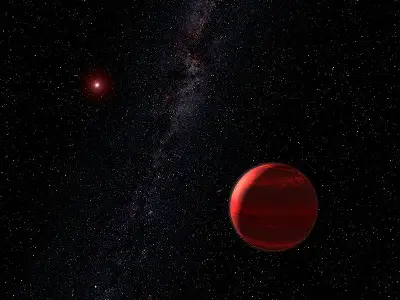| Back to Back Issues Page |
 |
|
Real World Physics Problems Newsletter - Red Sun, Issue #18 April 23, 2015 |
Life On Red Sun Planets
https://www.real-world-physics-problems.com/images/red_sun2.jpg Source: NASA, ESA and G. Bacon (STScI)
Last time I mentioned that the brightness of a red dwarf is much less than that of our sun, so life on red dwarf planets would have to evolve ways to survive in the presence of lower solar radiation. Plant foliage, for example, would probably be black in color in order to absorb as much solar radiation as possible, to enable photosynthesis to occur. But black foliage is only one small characteristic among the myriad of possible characteristics that life on these planets will exhibit. Imagine sunset at all hours of the day. On earth we have evolved to be adapted to much brighter levels of sunlight than is the case with red dwarf stars. The brightness provided by a red dwarf star will probably be akin to our sunsets. The deep and fading red glow of our sunsets during dusk is probably a good comparison of what the average day would be like on a red dwarf planet. Or imagine sitting by a campfire and watching the embers slowly fade into a dim red glow. This dim glow is the same as the amount of daylight you would see on a red dwarf planet. Most animals living on such a planet would perhaps have excellent night vision, similar to cats and owls, in order to take optimal advantage of the lower levels of light. Due to the lower solar radiation, these animals would perhaps (on average) move slower than creatures on earth due to less energy available to feed their bodies. There is simply less energy available in the food chain if the parent star has less energy to provide the planet. Animals would have interesting ways of hunting as well. They would probably rely more on techniques that don't depend on vision, such as echolocation, which is what bats use. The nocturnal predators on earth may resemble the daytime predators on red dwarf planets in the way they hunt their prey.
|
| Back to Back Issues Page |
